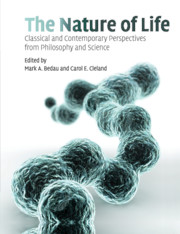Book contents
- Frontmatter
- Contents
- Preface
- Acknowledgments
- Sources
- About the authors
- Introduction
- SECTION I CLASSICAL DISCUSSIONS OF LIFE
- SECTION II THE ORIGIN AND EXTENT OF NATURAL LIFE
- 8 The origin of life: a review of facts and speculation
- 9 Small molecule interactions were central to the origin of life
- 10 Are the different hypotheses on the emergence of life as different as they seem?
- 11 The universal nature of biochemistry
- 12 Is there a common chemical model for life in the universe?
- 13 Searching for life in the universe: lessons from Earth
- 14 The possibility of alternative microbial life on Earth
- 15 Introduction to the limits of organic life in planetary systems
- SECTION III ARTIFICIAL LIFE AND SYNTHETIC BIOLOGY
- SECTION IV DEFINING AND EXPLAINING LIFE
- Supplementary bibliography on life
- Index
- References
10 - Are the different hypotheses on the emergence of life as different as they seem?
Published online by Cambridge University Press: 10 November 2010
- Frontmatter
- Contents
- Preface
- Acknowledgments
- Sources
- About the authors
- Introduction
- SECTION I CLASSICAL DISCUSSIONS OF LIFE
- SECTION II THE ORIGIN AND EXTENT OF NATURAL LIFE
- 8 The origin of life: a review of facts and speculation
- 9 Small molecule interactions were central to the origin of life
- 10 Are the different hypotheses on the emergence of life as different as they seem?
- 11 The universal nature of biochemistry
- 12 Is there a common chemical model for life in the universe?
- 13 Searching for life in the universe: lessons from Earth
- 14 The possibility of alternative microbial life on Earth
- 15 Introduction to the limits of organic life in planetary systems
- SECTION III ARTIFICIAL LIFE AND SYNTHETIC BIOLOGY
- SECTION IV DEFINING AND EXPLAINING LIFE
- Supplementary bibliography on life
- Index
- References
Summary
INTRODUCTION
The scientific field devoted to the study of the origin of life is characterized by its high degree of controversy. Disagreement among the active participants in research seems to run very deep and relate to the most basic features of the various models proposed. This probably stems from the relative novelty of the field, from its interdisciplinary nature which brings together scientists who use different methodological and theoretical categories, and above all, from the inevitable speculative dimension of the subject. Despite this pronounced division, there is a most basic common denominator which binds together all researchers of the emergence of life. This common element, which I will coin “the continuity thesis,” is the assumption that there is no unbridgeable gap between inorganic matter and living systems, and that under suitable physical conditions the emergence of life is highly probable. It is the adoption of the “continuity thesis,” concerning the philosophical dimension of life-matter relationship, which has turned the origin of life into a legitimate scientific question, and which constitutes a necessary condition for any scientific research in this domain.
The “thesis” is reflected in the different researchers' attempts to base the emergence of the biological features of self-organized systems upon universal physical principles and the physico-chemical properties of these systems. I claim that the continuity thesis, which is a philosophical presupposition, though strengthened by research in the field, is not derived from it.
- Type
- Chapter
- Information
- The Nature of LifeClassical and Contemporary Perspectives from Philosophy and Science, pp. 137 - 156Publisher: Cambridge University PressPrint publication year: 2010



